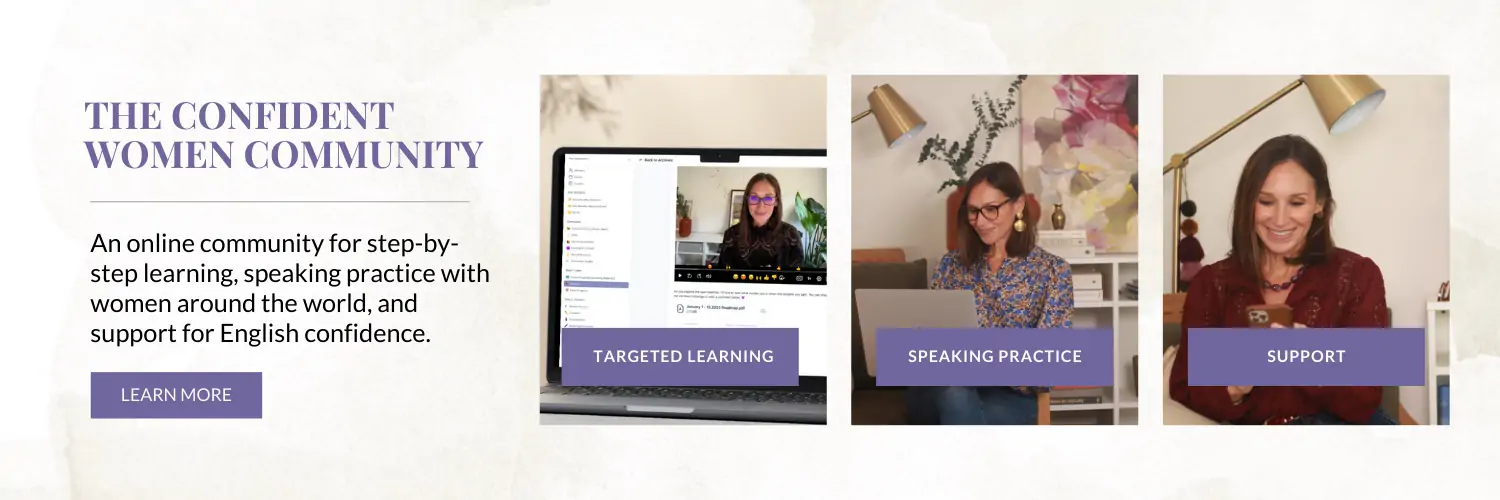#302: Master Spontaneous Speaking: Proven Strategies to Boost Your English Fluency

Tell me if this sounds familiar.
You’re listening to a conversation in English — at work, with your child’s teacher… maybe even in a conversation with me, and the whole time you’re thinking:
- “What am I going to say?
- What will the question be?
- What if I don’t understand the question?
- What if I don’t have an answer?
- What if I feel stuck?”
The whole time you are in the conversation, your anxiety skyrockets. The more nervous you become, the harder it is to think fast in English. Or to speak in the moment when you need to.
Perhaps you feel like you just can’t speak spontaneously in English. Or that you can’t respond quickly to questions.
If that’s you, congratulations. You’re here. We’re going to solve that challenge together.
This is solvable. I’m going to share strategies you can use to master spontaneous speaking — in English! — and boost your fluency.
You’ll definitely have those lightbulb moments throughout this lesson. You’ll think: yes! Of course! This makes sense.
You’ll feel inspired. And that’s awesome.
From there, it’s time to practice. Here’s why:
Inspiration doesn’t lead to progress. Practice does.
Master Spontaneous Speaking: Proven Strategies to Boost Your English Fluency — Summary
👉 To get the most from this lesson with all of my practice tips, be sure to watch the video.
[00:00] Do you ask these questions in English conversations?
[02:21] Strategy 1: Shift the Listening Focus
[04:36] How to Practice Strategy 1
[08:12] Strategy 2: Focus on Flow
[11:16] How to Practice Strategy 2
[14:31] Strategy 3: Follow a Smart Structure
[16:30] How to Practice Strategy 3
Strategy #1: Shift Your Listening Focus
Let’s revisit that scenario in a conversation with all those panicked questions: What will they ask? What if I don’t understand? What am I going to say?
When you listen to someone speaking and, at the same time, you’re internally thinking about all those what ifs…
This is called ‘listening to respond.’ It’s when someone in a conversation is more focused on how to respond if or when someone asks a question. When the brain is focused on what-ifs or fears, there is less focus on the person speaking. And this means missing important details.
I would argue this isn’t listening at all.
Does this describe you? If yes, what should you do instead?
Don’t listen to respond. Listen to understand. Understand the person speaking.
The truth is, the best speakers are the best listeners.
When you listen to understand, you are fully focused on the person speaking. You have all the information you need. You have the important details. The back story. And the full question.
Responding quickly to a question is SO MUCH easier when you have all the information you need.
I see this happen time and time again when I work with my students in Fluency School.
Every week the conversations get more challenging. However, my students feel less and less anxious because they learn the art of listening to understand.
Strategy #2: Focus on Flow
If you struggle with perfection, then you may have noticed that the pressure to speak with perfection leads to… feeling stuck. Saying nothing.
Perfection can stop a conversation. Rather than focus on perfection, focus on flow. In a conversation, flow is the effortless and uninterrupted progression of ideas and responses in a conversation.
This will transform your fluency, and here’s why:
Fluency is the ability to express yourself easily and articulately. That is the definition of fluency. Articulately means expressing yourself easily, clearly, and effectively.
When you shift to focusing on flow, you can respond spontaneously and keep conversations moving forward.
Let me show you what I mean, and then I give you practical action steps.
Let’s say you’re in a conversation with a group of new parents. They’re all talking about a book they read. You’ve never even heard of this book. So you’re feeling worried about what you’ll say when they ask what you thought about it.
And they do. Someone looks at you and says, “Didn’t you love it?”
You have two options for your response:
Option A: “I didn’t read it.”
Then there’s an awkward silence. It feels uncomfortable. And the group moves on in the conversation.
Option B: “I haven’t read it yet, but it sounds like I should! What did you like best about it?”
Now, someone responds with enthusiasm and tells YOU about the book. You are part of the conversation. And you helped move it forward.
You responded in a quick, clear, effective way — you responded with flow.
So, how can you begin to develop your flow? Here are 3 practice action steps:
- Keep it simple.
- Use and/but.
- Buy time when you need it.
Strategy #3: Follow a Smart Structure
If you’re unsure of where to start or what to say next, following a structure is a great way to overcome the uncertainty.
Here’s a response structure that works every time.
- What: introduce your problem, thought, idea, etc.
- So What: provide reasons or explain why it’s important
- Now What: describe the main takeaway or what actions need to be taken
For example:
- What: I think we should paint the living room light blue.
- So What: The color is calming and easy on the eyes.
- Now What: Let’s narrow down a few light blues that we like and decide with the kids.
Using a structure like this keeps the response simple, removes the guesswork of what to say, and – with practice – develops your ability to think fast in English.
Here are two more structures to consider:
- Point/reason/example: State your point, give the reason behind it, and illustrate with an example.
- Problem/Solution: State the problem, then present your solution.
Share Your Comments/Questions
Did you have an aha moment with this lesson? Tell me what it was.
And then, tell me how you’ll practice what you learned. Remember: Inspiration doesn’t lead to progress; practice does.
Share your thoughts and questions with me below.
~ Annemarie

Get the Confidence to Say What You Want in English
Follow my 3-step solution to speak English with clarity, fluency, and freedom so you can say what you want with confidence.
You'll also get my Confident English lessons delivered by email every Wednesday and occasional information about available courses. You can unsubscribe any time.
More Like This
Learn English Phrasal Verbs Faster — 5 Minute Routine
Tired of forgetting English phrasal verbs the moment you need them? In this Confident English lesson, you’ll learn a 5-minute daily routine to make phrasal verbs stick—so you can remember them, use them naturally in real conversations, and finally stop second-guessing. Whether you need phrasal verbs for work, everyday conversations, or English speaking practice, this lesson gives you practical steps that fit your real life.
Sound Fluent & Professional: English Phrases for Meetings & Updates
Want to speak English more naturally at work? In this lesson, you’ll learn powerful English phrases for meetings and updates, including business phrasal verbs professionals use every day. Get the vocabulary and expressions you need to give confident project updates, explain delays clearly, and wrap up your message like a pro.
How to Give a Project Update in English at Work
Give a clear project update in English with a concise 3‑step framework. Get the phrases and structure to deliver professional project status reports confidently at work.
Professional Ways to Ask for Help in English (4-Step Formula)
Learn how to ask for help in English at work—without sounding unsure or unprepared. This 4-step formula gives you clear, professional phrases for meetings, emails, and team collaboration.
30+ English Phrases to Compliment Food Naturally and Politely
Learn 30+ natural English phrases for food and how to compliment food in English politely and sincerely. Perfect for dinner parties, eating out, and everyday English conversations.
Describe Food in English: The Ultimate List of Taste & Texture Vocabulary
Learn how to describe food in English with confident, natural vocabulary. Get taste and texture adjectives English speakers use in real conversations, from restaurants to everyday life.
© Copyright 2014-2025 Speak Confident English | Privacy Policy | Terms & Disclaimer | Online Class Policies






Hi Annemarie and All, I think filler words and filler sentences provide a good way to buy time when we need time to gather our thoughts.
It would be nice to see if one of the upcoming videos would touch this topic.
thank you, J.
Hi Judit, thank you for the comment. Some fillers words/sounds can be useful but only at a very minimum. It’s important to be careful when overusing them. I’d be happy to do a lesson on this. 😊
I am looking forward to start the courses in September. Don’t forget me, I am in the waiting list !
Wonderful! You’ll be getting a preview of my Fluency School program starting Monday, September 2. 🙌
Hi Annemarie, first. Thank you so much for each subject, i’m learning a lot with you and your methodologics is amanzing. I always find myself in this situation when you say that during a conversation we are thinking about how we are going to respond. I often answer something that may not be what I was asked, all because I am trying to put the words together and I don’t have active listening. Thank you for sharing so much valuable content, it is already helping me a lot in my fluency in speaking English:)
Hi Suelen, thank you so much for your kind comment. And thank you for watching my lessons. I’m happy to hear this lesson was helpful and I hope that with a switch to active listening you’ll find it easier to respond in the moment. 😊